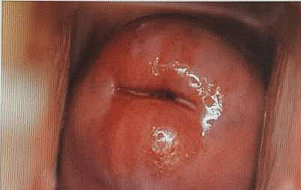D. Reassurance – Explanation
notlinked to the development of cervical cancer or any other condition that causes
cancer.Treatment can be offered if the cervical ectropion is causing problems such as
bleedingor pain during or after sex. However in this case, the cervix is not bleeding on
touchthus no treatment is needed.
Remember: An asymptomatic cervical ectropion should be left alone.
Cervical ectropion
- This occurs when the columnar epithelium of the endocervix is displayed beyond
the os. The stratified squamous epithelium that normally lines the vaginal part of the
cervix (ectocervix) is replaced by columnar epithelium, which has migrated from the
endocervix.- The cervix enlarges under the influence of oestrogen and as a result the
endocervical canal is everted. Exposure of high levels of oestrogen usually
occurs at certain times (e.g. puberty, in pregnancy or women on COCP) - It is seen on examination as a red ring around the os and is so common as to
be regarded as normal - It is generally an asymptomatic condition but patients occasionally present with
bleeding or excessive discharge - The discharge if present is usually clear, watery in consistency and without
odour - Once a normal cervical smear has been confirmed, it is actively managed only if
there are symptoms. - After stopping any oestrogen-containing contraceptive, treatment options
include diathermy, or cryotherapy
- The cervix enlarges under the influence of oestrogen and as a result the
CERVICAL ECTROPION
Cervical ectropion occurs when the columnar epithelium of the endocervix is displayed
beyond the cervical os. The stratified squamous epithelium that usually lines the
vaginal part of the cervix (ectocervix) is replaced by columnar epithelium, which has
migrated from the endocervix

Cervical ectropion – red ring around the os
The cervix enlarges under the influence of oestrogen, and as a result, everts the
endocervical canal. Exposure of high levels of oestrogen usually is seen in pregnancy
or women on COCP.
It is usually asymptomatic however woman occasionally present with post-coital
bleeding or excessive non-purulent discharge.
It is managed if symptoms are bothersome. Treatments include cautery with silver
nitrate, diathermy and cryotherapy. That being said, it is essential to obtain a cervical
smear and ensure it is normal prior to any treatments
